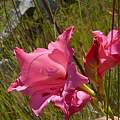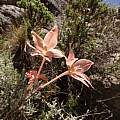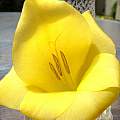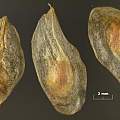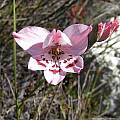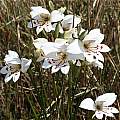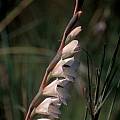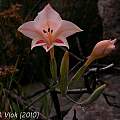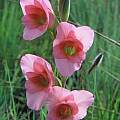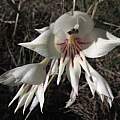There are about 163 species of Gladiolus (with new ones being discovered) in the area south of the Tropic of Capricorn and including Botswana, Lesotho, Namibia, South Africa, Swaziland, and Mozambique. Some are found in winter rainfall areas and some in summer rainfall areas. For more information see Goldblatt and Manning, 1998. Southern African species from Ce-E are pictured on this page.
Gladiolus index - Southern African gladiolus A-B - Southern African gladiolus Ca - Southern African gladiolus F-H - Southern African gladiolus I-Me - Southern African gladiolus Mi-Pa - Southern African gladiolus Pe-R - Southern African gladiolus S-T - Southern African gladiolus U-Z - Gladiolus Hybrids - Miscellaneous gladiolus
Gladiolus ceresianus L.Bolus grows on stony slopes and flats in clay soil from southern Namaqualand to the western Karoo and in the Roggeveld and Bokkeveld Plateau. It is a small plant, up to 10 cm tall with linear leaves with four longitudinal grooves and one to four flowers in a inclined spike that are brown to purple with dark veining. Flowers are pleasantly scented. This species flowers from August to October in the wild. Flowers are similar to Gladiolus uysiae, but that species has flat leaves. It is also very similar to Gladiolus virescens, but has dark, hard scales around the corms. Photo 1 from Cameron McMaster taken on the Matjiesfontein Sutherland road in the Roggeveld, photo 2 from Alan Horstmann, and photo 3 from Rod Saunders. The last two photos from the book Plants of the Klein Karoo courtesy of Jan and Anne Lise Schutte-Vlok.
Gladiolus citrinus Klatt see Gladiolus trichonemifolius
Gladiolus comptonii G.J.Lewis is a rare plant that grows on rocky sandstone slopes in the northwest Cape in a localized area on Heerenlogement Mountain at the northwestern end of the Olifants River Mountains. Plants grow 45 to 60 cm high. The leaves are linear and the few bright yellow short tubed flowers have brown streaks on the lower tepals. This species flowers mid to late July (winter). Photo taken by Rachel Saunders.
Gladiolus crassifolius Baker (syn. G. rachidiflorus, G. thomsonii, G. masukuensis, G. mosambicensis, G. tritoniiformis, G. junodii, G. coranthii, G. gazensis, G. dieterlenii) is a widespread species of eastern southern Africa. It is found also in tropical Africa. Plants in southern Africa usually grow in hilly country in well-drained rocky grassland habitats and bloom late summer. Plants in tropical Africa bloom earlier before the new season’s leaves have developed. Flowers are borne in a 16 to 22 flowered spike and are usually pale to deep pink or light purple. The lower lateral tepals have a dark band of color across the lower half of the limbs. Plants grow up to 75 cm. Photos taken by Cameron McMaster at Maclear and Sentinel Peak in the Eastern Cape in 2008.
Gladiolus crispulatus L. Bolus is a rare endemic that is found in the Southwestern Cape on south facing slopes between Swellendam and Riversdale. Growing to 30-40 cm, it has four or five superposed leaves, with the midribs lightly thickened and usually paired on one side and single on the other, and deep pink flowers with triangular median streaks and dark spots in the throat. It is similar to Gladiolus oreocharis but has larger flowers and different leaves and to Gladiolus carneus which also has different leaves and tepal markings. If flowers November-December, but usually only in the first several years after a fire so is rarely seen. The first photograph from Rachel Saunders was taken close to the top of the Langeberg Mountains. The next photos from iNaturalist were taken by Brian du Preez in November in the Western Cape and lennartn in November near Swellendam and shared under CC BY-SA and CC BY-NC licenses.
Gladiolus cunonius (Linnaeus) Gaertner (syns. Anomalesia cunonia, Antholyza cunonia) has bright red flowers and blooms in the spring and grows in sandy soils near the coast. Plants grow from 20-70 cm high. The first three photos were taken by Bob Rutemoeller and Mary Sue Ittner and the next three by Cameron McMaster in habitat near Agulhas and Arniston in the Overberg. The last picture shows the seed capsules hanging over the cliff near the ocean.
Gladiolus cylindraceus G.J.Lewis grows on rocky sandstone slopes and ridges in low fynbos vegetation at elevations above 1500 m in the Ceres District of the Southwest Cape. Growing to 50 cm, it has three distinctive linear leaves with the lower one or two basal and the lowermost reaching to between the base and apex of the spike, sheathing the stem and cross shaped in transverse with wide grooves. The unscented flowers are pale pink to salmon with a diamond shaped red mark sometimes with a white to yellow center on the lower tepals. The tube is slender and elongate, up to 52 mm long. It flowers December to January. Photos from Rod Saunders and Rachel Saunders. The first was taken on the Waboomsberg Mountain and the others in the Witsenberg Mountains where there were flowers in colors from pink to apricot to almost yellow.
Gladiolus dalenii Van Geel is a widespread and common species found not only in Southern Africa, but also in other parts of tropical Africa. It has been known by a number of names over the years; there have been 27 synonyms for the tropical Africa and Madagascar forms and 14 more for the southern African forms. The main synonyms for the southern Africa collections have been Gladiolus natalensis and Gladiolus psittacinus. This species blooms at different times of the year depending on the location, but there are probably flowers every month of the year somewhere in its native habitats. Flowers are either red to orange with yellow markings on the lower half of the three lower tepals or yellow to greenish with red to brown streaks on the upper tepals. Plants can grow 1-2 m high. Although it favors moist habitats and is often found in grassland, it can also be found in dry habitats with only a short wet season. The ones I grew in Northern California lived for a number of years in the garden, dormant during our wet winters, appearing late spring and surviving through the dry summer and blooming in the fall. The flowering stalks were very tall with a number of flowers. Photos 1-2 of those plants were taken by Mary Sue Ittner. Photo 3 by Cameron McMaster shows plants in cultivation. Photos 4-5 by Mary Hunter and Mary Sue Ittner show the first bloom from seed of a yellow form of ssp. dalenii, once known as Gladiolus primulinus blooming in late summer in Northern California. The last photo by David Pilling shows seed.
The first photo below from Cameron McMaster shows flowering plants in habitat in the Eastern Cape. The second is another habitat shot taken near Balloch in the Eastern Cape, January 2010 by Bob Rutemoeller. Photo Nr. 3 from Rachel Saunders shows an unusual color form and was taken in northern KwaZulu-Natal in January 2015. The last photo shows the beautiful detail on likely the same color form, as the seeds were obtained from Silverhill, flowering the second year from seed for Martin Bohnet.
Gladiolus debilis Ker Gawler is found on rocky sandstone slopes in the southwest Cape, blooming in spring with white to pale pink flowers with red markings on the lower tepals. Height range: 25-45 cm. The first photo by Mary Sue Ittner was taken in September 2001 in an area in the southwest Cape that had burned the year previously and the second was taken by Bob Rutemoeller September 2003 at Boskloof. The third was taken by Ragnhild Crawford. Photos four and five taken near Napier in the Overberg by Cameron McMaster. The sixth photo was taken by Andrew Harvie at Silvermine in Table Mountain National Park. Last photo by Christopher Whitehouse taken at the Phillpskop Mountain Reserve near Stanford.
Gladiolus delpierrei Goldblatt grows on marshy sandstone slopes at 1200 m in the Cederberg Mountains. Growing from 40-45 cm high and blooming December to January, it has yellowish cream flowers with yellow and red marking on the lower tepals. Photo taken January 2014 by Rachel Saunders.
Gladiolus densiflorus Baker is a species found in the lowveld and coast of eastern southern Africa. It grows to about 1 m in open grassland, usually on deep soils in high (summer) rainfall areas. It has small, short tubed, cream, greenish, pink, mauve, slate-grey or occasionally orange flowers that are usually minutely speckled with pink to purple spots. Photo taken by Rod Saunders.
Gladiolus deserticola Goldblatt is restricted to the Richtersveld, a mountainous area of northern Namaqualand. Plants grow in sheltered sites, most frequently in clay soils on south-facing slopes protected by rock or shrubs. Flowers are dark blue with a darker line in the midline of the tepals. The lower tepals or the lateral lower tepals are cream edged with purple. Flowers are weakly rose scented. Height: 10-20 cm. Photo from Rachel Saunders who found a single specimen blooming in July 2011, a bit early for this species that usually blooms mid August to mid September.
Gladiolus dolichosiphon Goldblatt & J.C-Manning was first described in 2009, after a first collection from 1986 wasn't correctly identified as new species. It grows on seasonally wet places on cool south-facing slopes in altitudes above 1300 m in the western little Karoo. The flower spike holding 4 to 7 seven pink to creamy salmon unscented flowers with the lower three tepals each with a pale lozenge-shaped median mark outlined in dark red may have up to two lateral branches. It is a member of the long tubed pink flowered Gladiolus carneus complex but is distinguished from that group by its 5 or 6 linear leaves, creamy pink to salmon flowers with a tube 30-50 mm long and longer than the dorsal tepal, and its late summer flowering (late January to mid February). Height range: up to 40 cm. The first photo from Rachel Saunders was taken the second year after a fire, January 2017. The second photo from the book Plants of the Klein Karoo courtesy of Jan and Anne Lise Schutte-Vlok.
Gladiolus dolomiticus Obermeyer is a rare summer rainfall endemic found on dolomite hills, dry woodland, and dolomite slopes at 1700 m in Makapan's Valley in the Northern province. It flowers in March and April at the end of the rainy season. Growing 70 to 100 cm with rigid hairy leaves with thickened margins and primary and secondary veins, it has a spike of 10 to 17 short tubed pale pink flowers. The lower tepals have a blotch in the midline and the throat is pale yellow. Photo from Rachel Saunders.
Gladiolus ecklonii Lehmann (syn. G. marmoratus, G. inclusus) is widespread in the summer rainfall area where it is found in well watered low grassland. It has flowers that are minutely spotted or dotted pink, red or purple on a white background. The lower tepals are yellow to cream. The flowers may be so evenly covered with uniformly pink or dark red spots that they look that color. From a distance the flowers on my plants looks almost brown. The attractive leaves are bright green in a fan with thickened margins. Height range: 15-35 cm. The species is named after C. F. Ecklon, the plant collector who first sent seeds of it to the Hamburg Botanic Garden. The first two photos are of plants blooming September 2004 in California by Mary Sue Ittner.
The first four photos were taken by Cameron McMaster in the Eastern Cape and the last was taken by Rod Saunders.
Gladiolus edulis Burch. ex Ker Gawler see Gladiolus permeabilis
Gladiolus engysiphon G.J.Lewis is found in clay and granitic loam in renosterveld and grassland in the Langeberg Center (Swellendam to Mossel Bay). Growing from 35 to 50 cm high, it flowers March to April. The cream flowers with red median streaks are arranged in a 2 to 6 flowered spike. Photos taken by Rogan Roth in the southern Cape in April 2021. He first thought it was Gladiolus bilineatus which has a similar flower, distribution, and flowering time in the autumn. Both are pollinated by a species of long-proboscid fly. According to John Manning the lowest leaf in Gladiolus bilineatus always develops a short, sword-shaped blade, whereas the leaf blades in Gladiolus engysiphon are either absent entirely or needle-like. The arrangement of the leaves and the diameter of the stem is also different in the two species.
Gladiolus equitans Thunberg is very similar to Gladiolus alatus but has short, broad leathery leaves with raised margins and grows on rocky hills in Namaqualand. The first one was photographed in Namaqualand in August 2001 just after it rained by Mary Sue Ittner. The second photo was taken in about the same place in September 2006 by Bob Rutemoeller, but the plants were already in seed this time. The third picture was taken by Rod Saunders. The fourth and fifth photos were taken in habitat in the Kamiesberg by Andrew Harvie.
Photos below were taken by Alan Horstmann.
Gladiolus exilis G.J.Lewis is a fall-blooming, winter-growing species from the mountains of the Western Cape where it grows in clay loam in fynbos. Growing from 25-45 cm tall, it has white to pale blue fragrant flowers with dark streaks on the lower tepals. It looks similar to Gladiolus gracilis. Photos from iNaturalist taken by Peter Thompson in the Western Cape in May and shared under a CC BY-NC license.
Gladiolus index - Southern African gladiolus A-B - Southern African gladiolus Ca - Southern African gladiolus F-H - Southern African gladiolus I-Me - Southern African gladiolus Mi-Pa - Southern African gladiolus Pe-R - Southern African gladiolus S-T - Southern African gladiolus U-Z - Gladiolus Hybrids - Miscellaneous gladiolus












